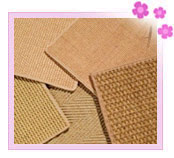Floor coverings have been quite common in the eastern part of the globe
including Turkey, Persia (Iran), China, India and the regions around. Be the
knotted carpets or woven durries and kilims, they have been an integral part
of the culture here.
Flat woven durries and kilims of cotton or wool made the first floor
coverings, centuries ago. They were woven by ladies in their free time for
their household use to insulate against cold. Gradually with the advent of
knotted oriental carpets, the purpose changed. Carpets are now used for home
accents, decor and beauty rather than a simple utility.
The modern world has a vast variety of floor coverings to choose from. They all have as varied properties and utilities.
Knotted Carpet - They are
also known as the oriental carpets. They are pilled carpets made of wool or
silk on cotton or silk base. They are rich in color and patterns. The
designs are as vast as the regions they are practiced in. The origin is the
tribes of Turkey and Persia and usually the place of origin can be
identified from the pattern, intricacy and the density and style of knots.
Kashmir in India is famous for its silk and wool carpets.
Tufted carpets - The origin of tufted carpets can be traced to
America in 1930. They are a cheaper version of the knotted carpets. They
have the same patterns and the intricacies as knotted carpets but not the
same durability. The tufts are anchored in a plain woven cloth. To provide
endurance the backside is first covered with latex glue and then the
secondary backing. They form the economical range of carpets.
 Flat Weaves -
Flat Weaves - The flat weave carpets of India are called durries.
They were earlier woven by almost every household for their personal use.
The patterns vary with the region. Panipat is known for geometric patterns
and Andhra Pradesh for Ikkat patterns. The yarn can be either cotton or
wool. Flat weaves of Turkey are called Kilim and are known for their
intricate patterns. The major difference lies in the weaving style. In a
kilim, the new colored yarn of the weft is not joined to the previous color
this creating a slit along the pattern.
Namdah - It is the felt wool carpet. The felted wool is embroidered with
chain stitch as in kashmir in India and parts of Iran or appliqued as in
Rajasthan in India or some tribal belts of Iran. The patterns range from
bold geometric to intricate Persian.
Synthetic Carpets - They may be pilled or non woven types made of
the synthetic yarn. They have gained popularity later due to their
versatility and durability. They may be single colored or multicolored and
in the form of accent rugs or wall to wall carpeting.
Jute carpets - They are flat woven jute, pilled or braided. They
form one of the most beautiful and environment friendly area rugs. The
natural golden color of jute is attractive in itself and it can also be
bleached or dyed.
The carpets need to be selected keeping in mind the utility, the purpose
and the traffic of the area where it needs to be installed. The kind of
soiling they face and the kind of maintenance that they require are also
major factors.



 Flat Weaves - The flat weave carpets of India are called durries.
They were earlier woven by almost every household for their personal use.
The patterns vary with the region. Panipat is known for geometric patterns
and Andhra Pradesh for Ikkat patterns. The yarn can be either cotton or
wool. Flat weaves of Turkey are called Kilim and are known for their
intricate patterns. The major difference lies in the weaving style. In a
kilim, the new colored yarn of the weft is not joined to the previous color
this creating a slit along the pattern.
Flat Weaves - The flat weave carpets of India are called durries.
They were earlier woven by almost every household for their personal use.
The patterns vary with the region. Panipat is known for geometric patterns
and Andhra Pradesh for Ikkat patterns. The yarn can be either cotton or
wool. Flat weaves of Turkey are called Kilim and are known for their
intricate patterns. The major difference lies in the weaving style. In a
kilim, the new colored yarn of the weft is not joined to the previous color
this creating a slit along the pattern.